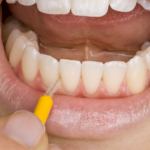
While regular twice daily toothbrushing with a fluoride toothpaste is the cornerstone of an effective oral hygiene regimens interdental cleaning is also an important aspect and a wide range of devices are marketed for this purpose, including dental floss, interdental brushes, water jet devices, toothpicks, and other devices. Although evidence regarding the most effective method is equivocal and few direct comparisons have been undertaken.
The aim of this review was to assess the comparative efficacy of interproximal oral hygiene (IOH) aids using a using Bayesian Network Meta-Analysis.
Methods
Searches were conducted in the Medline, Embase, Web of Science databases supplemented with searches of the journals; Journal of Periodontology, Journal of Clinical Periodontology, The International Journal of Periodontics and Restorative Dentistry, and International Journal of Dental Hygiene. Randomised controlled trials (RCTs) assessing IOH aids and reporting outcome measuring gingival inflammation, plaque, or probing depth and with a minimum of 2 weeks follow up were considered.
Two reviewers independently selected studies abstracted data and assess study quality using the Cochrane risk of bias tool. A random effect arm-based (AB) network meta-analysis (NMA) model was used for each outcome,
Results
- 22 RCTs involving a total of 2030 patients were included.
- 4 studies were considered to have a low risk of bias, 1 a high risk of bias and 17 an unclear risk of bias.
- Study sample sizes ranged from 10 to 110 patients and follow up from 4-24 weeks.
- The studies used 10 major IOH methods flossing (FL), powered flossing (FL2), toothpicks (TP), toothpicks and intensive oral hygiene instructions (TO), water jet irrigation devices (WJ), interdental brushes (IB), gum massaging devices (MD), toothbrush only (Ctrl), powered, electric, sonic toothbrush (Powered Ctrl), Powered control and water jet (PW).
- NMA showed that for bleeding on probing the greatest reduction was seen with toothpick and intensive oral hygiene instruction (26.4% [95% CI: 7.50, 45.4]); waterjet had the next largest reduction with an average of 19.3% (95% CI: 16.2%, 22.4%) with relatively smaller reductions for floss
Conclusions
The authors concluded: –
our network meta-analysis demonstrated that unsupervised flossing does not yield substantial reduction in gingival inflammation. Among 10 IOH aids, interdental brushes and water-jets ranked high among other aids for reducing gingival bleeding. Selection of a single IOH aid as the gold standard is not possible based on existing data as their effectiveness depends on ease of use, appropriate instruction and interdental anatomy and periodontal status. Most importantly, the patient-perceived benefit of the IOH aids is not clear because most studies investigated disease-oriented outcomes of gingival health, providing only limited information what matters to patients. In the absence of strong evidence about IOH aids differences in the impact on patients, practitioners should customize IOH aid recommendations and offer alternatives rather than insisting on instruction on the use of a universally recommended cleaning aid. Further well designed and appropriately powered clinical trials are warranted to provide more authoritative guidelines on IOH selection
Comments
A 2011 Cochrane review by Sambunjak et al (Dental Elf – 11th Dec 2011) included 12 RCTs a some evidence to suggest that flossing in addition to toothbrushing reduces gingivitis compared to toothbrushing alone, and weak unreliable evidence for a small plague reduction. While the 2013 Cochrane review of interdental brushes by Poklepovic et al (Dental Elf – 14th Jan 2014 ) included 7 RCTs only one of which was at low risk of bias providing low quality evidence that interdental brushing reduces gingivitis when compared with flossing at one month. A meta-review by Sälzer et al (Dental Elf – 20th Apr 2015) included 6 earlier reviews examining floss, interdental brushes, woodsticks and oral irrigators and concluded that interdental brushes were the most effective.
The current review used a NMA approach which allows for indirect comparisons. However, it should be noted that only 4 of the included studies were considered to have a low risk of bias and none of the studies were long term. Looking at the network plots for two of the main outcomes reported gingival inflammation and bleeding on probing many of the indirect comparisons only involved single studies. So while this review found that interdental brushes and water-jets produced the greatest improvement in gingival inflammation the supporting evidence is of low quality and this needs to be taken into consideration when interpreting the findings.
Links
Primary Paper
Kotsakis GA, Lian Q, Ioannou AL, Michalowicz BS, John M, Chu H. A network meta-analysis of interproximal oral hygiene methods in the reduction of clinical indices of inflammation. J Periodontol. 2018 Feb 19. doi: 10.1002/JPER.17-0368. [Epub ahead of print] Review. PubMed PMID: 29520910.
Other references
Dental Elf – 20th Apr 2015
Dental Elf – 14th Jan 2014
Only low quality evidence available for effectiveness of interdental toothbrushes
Dental Elf – 11th Dec 2011
People who brush and floss regularly have less gum bleeding compared to toothbrushing alone
Picture Credits
By Clairemeaker – Own work, CC BY-SA 4.0
